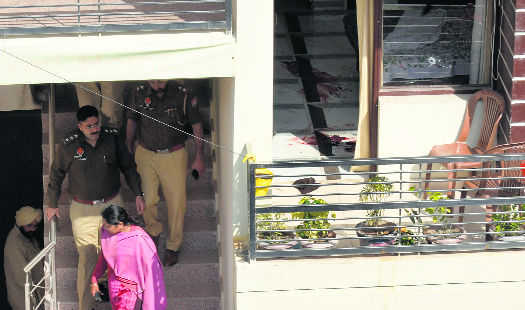
Fatal: Dreaded gangster Ankit Bhadu was killed in the Zirakpur encounter.
Rajbir Deswal
Former Joint Director, Haryana Police Academy
THE location of police encounters is usually a culvert, a jungle, bridges, railway tracks, subways, fields or abandoned buildings. Not that this is just by default; it can be by design also, since for extra-judicial killings, as is generally believed, there may be things the police want to hide from public view.
However, the recent encounter at Zirakpur by the Organised Crime Control Unit of the Punjab Police left much to be desired as far as the ‘urban operations’ standard operating procedure is concerned. Credit goes to the Punjab Police for decimating a dreaded gangster, Ankit Bhadu, wanted in over a score of criminal cases and carrying a reward of Rs 1 lakh on his head. The chasing cops ultimately delivered, putting their lives in danger. The inter-state gangster had been a headache for people in Punjab, Haryana, Himachal Pradesh, Delhi, Rajasthan and Uttar Pradesh for his role in extortion, gang war and liquidating rivals. The criminal had the audacity to shoot at the raiding police team and was a potential threat to the life and liberty of people at large.
Sadly, the incident leaves behind a trail of related issues. First and foremost is the question: Are the police fully trained to engage fugitive criminals in inhabited areas, where there is every possibility of innocent citizens being hurt or even killed in crossfire? The anxiety on the part of the cops on the trail of the criminals is obvious, since for days and months they keep chasing them, till the latter are engaged at an appropriate time and place. The police cannot decide where they might have to indulge in what they call an ‘encounter’. But would it be justified to expose the public to the gory scenes which they might not be used to witnessing? Such operations need to be planned meticulously, allowing the people around to have faith in security aspects of their cohabitation.
Having been the Joint Director of the Haryana Police Academy, Madhuban, I recall a training programme organised in collaboration with the National Police Academy (NPA), Hyderabad, regarding ‘urban operations’ in 2015, which involved strategising the attack or zeroing on the criminals, maybe terrorists or gangsters, in a populated urban area. The idea was to gain entry into a building, where the suspects might be hiding or taking shelter, in a way that no civilians were harmed or traumatised. Fighting in the streets is different from jungle warfare; hence, the training. In the US, the UK and other Western countries, they use a technique called ‘kettling’ for smoking out the wanted criminals. The NPA module incorporated issues such as target analysis, approach to the target house, house intervention, multiple entry and hostage evacuation, arrest and control, vehicle intervention, slithering, embarkation and disembarkation, VIP security and study of explosives. This training was organised for officers from Punjab and Haryana and this module cries for replication in view of the Zirakpur operation.
Another question which can be asked in such a situation is whether the police are trained in hostage negotiations too, since the gangster jumped from the third floor to the second to take a six-year-old girl as hostage, threatening to shoot her in the head if he wasn’t given safe passage. One can understand that the strict rules of hostage negotiations cannot be applied in such a violent situation, but still if there was even one per cent chance for the criminal to settle for something like surrender, it could have been effected. In plane hijacking and kidnapping cases, hostage negotiation techniques result in a justifiable and justiciable rounding off of the critical scenario, for the hijacker eventually gets tired.
The third question is whether the Incident Command Centre will be established for meeting such exigencies, which are unusual and require for their tackling a concerted effort by various agencies in a joint operation. The pooling of their resources is most expedient. In an ‘encounter’ lasting five hours, as has been reported, there should have been pressed into service an ambulance, the fire brigade and volunteers from social organisations. In such situations, evacuation of people might have to be done. There could be any number of injured people who would need medical assistance there and then. I witnessed during a programme organised by the Federal Bureau of Investigation (FBI) at Louisiana University that every stakeholder department of the State took active part in containing such a critical incident without inviting the ire of the public or the media.
The fourth question relates to ‘tenant verification’, which the Dhakoli police have confirmed they had done in this case. Why should we always give this very important aspect the go-by is baffling. In urban dwelling units, which are available for hire, it should be a mandatory requirement for a property owner to have the person’s antecedents verified when he rents out or leases out his property. Reports suggest that the residents of the building in question confirmed that some ‘strange’ persons who looked like musclemen and goons had visited them. Awareness needs to be created among people residing in a building, colony, locality etc. about the necessity and importance of tenant verification. The Neighbourhood Watch system can be very effective in such a situation.
Last but not least is the question of psychological rehabilitation of the victims and witnesses of such an incident. Can the six-year-old girl, who was injured in the feet by the gangster, ever forget the traumatic moments? Counsellors should visit such victims till they come to terms with what they have been through.
These critical encounters aren’t there only for the police to take on; rather, various state agencies need to orchestrate such operations, which require transparency, not ‘in-house ops’ by the police.



























